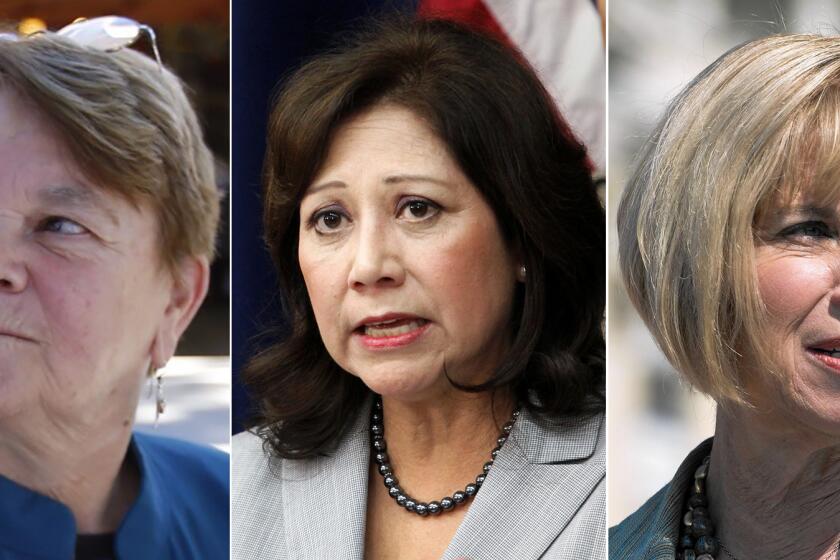Editorial: Redrawn supervisor districts can’t give L.A. County the representation it needs

- Share via
The new district lines for the Los Angeles County Board of Supervisors took effect last Wednesday, but it will be at least another six months and an election before it’s quite clear what they mean for the board’s direction.
Backsliding from the county’s current progressive policies is among the possibilities, because the new districts improve the chances that candidates less interested in government reforms will be elected to the board. Supervisor Sheila Kuehl, in a bitter and rueful letter to her constituents, predicted that the redrawn districts will result in an end to criminal justice reform.
Let’s hope she’s wrong. The current board has done much to refocus county government on revamping the criminal system and injecting a measure of equity into healthcare, housing, economic development and other county services, which in California are the last and best resort for the most deprived and marginalized among us.
Districts are redrawn every decade in response to new census data, to keep the power of each voter roughly equal by reshaping districts in response to population shifts. Voting rights laws also require districts that ensure racial and ethnic groups are not gerrymandered out of proportionate representation.
In a county in which five supervisors represent more than 10 million people — the most egregious shortchanging of political representation of any local government in the nation — there are only so many ways to draw those lines while complying with the rules. Redistricting steps on toes, severs productive relationships and also, quite possibly, changes the political orientation of the board.
With only five supervisors, each representing more than 2 million people, L.A. County is poorly represented. Redrawing district lines does little good.
It need not be that way. The problem with new boundaries that put, for example, the Hollywood Bowl and the Mojave Desert in the same district is not that the lines were drawn wrongly but that there aren’t enough of them. Supervisors with 2 million constituents apiece can pick and choose which of those residents to champion and which to ignore. They should have at most a third that many people to represent. Boundaries for smaller districts would not have to change nearly as much to ensure proper representation.
Do the math and you’ll see what that means — at least 15 districts with 15 supervisors. It’s a needed change but a heavy political lift. Current supervisors certainly don’t want their individual power diluted by a larger board, and county voters have rejected expansion on numerous occasions.
There can be tension between swift action and adequacy of representation. If there were just one dictatorial supervisor for the whole county, for example, that person might quickly dispense with the homelessness problem, although not necessarily in a way that meets the approval of the county’s people. Mussolini, the old apocryphal line goes, made the trains run on time. Even if that were true, let’s not forget that there’s no doubt he spread fascism, racism, war and death. Proficient and productive but unaccountable leaders are no recipe for stable or responsive government.
Los Angeles County hasn’t had a dictator, but for more than a century beginning in the 1870s its leadership was essentially a white men’s club that locked out others by drawing districts to perpetuate its power, even as the proportion of Latino residents continued to grow. The result was a kind of hardening of governmental arteries, manifested in backward-looking programs and policies that were constantly 10 or 20 years behind the needs of changing constituencies.
When he was a Los Angeles County supervisor, Zev Yaroslavsky had a quip about county government that his successor, Sheila Kuehl, likes to quote: A county of 10 million people run by a five-member Board of Supervisors is absurd.
It took a 1990 court order to finally require district lines that brought the Board of Supervisors ever-so-slightly up to date. But then a new board dynamic was locked in for another three decades — one Latino member, one Black member and three white members.
It was not the intention of the 2012 Board of Supervisors, when they drew lines for themselves and their successors, to create the current mostly progressive, all-female board. It’s just the way it worked out. Back then, the supervisors only wanted what all politicians want — to protect their power and their relationships with constituent groups, and to see that their policies and ideologies continued to hold sway after their departure.
The new lines, drawn for the first time by an independent commission, finally give Latinos enough clout to elect two supervisors and not just one. Yet they make up half the county’s population, so they’ll still be underrepresented.
Jail expansion was blocked in favor of alternatives to incarceration.
Drawing new lines takes us only so far. The L.A. County Redistricting Commission said as much in its final report, in calling for smaller districts and a larger board.
The recipe for continuing badly needed progressive reforms on a larger, more representative board would be for dedicated activists and service providers to double down on the creative organizing and involvement that pushed the current supervisors to action on, for example, closing rather than expanding Men’s Central Jail and providing care-based alternatives to incarceration rather than trying to make incarceration marginally less horrid.
That’s also the proper strategy in the meantime, while we’re stuck with an insufficiently representative or accountable five-member board.
More to Read
A cure for the common opinion
Get thought-provoking perspectives with our weekly newsletter.
You may occasionally receive promotional content from the Los Angeles Times.












